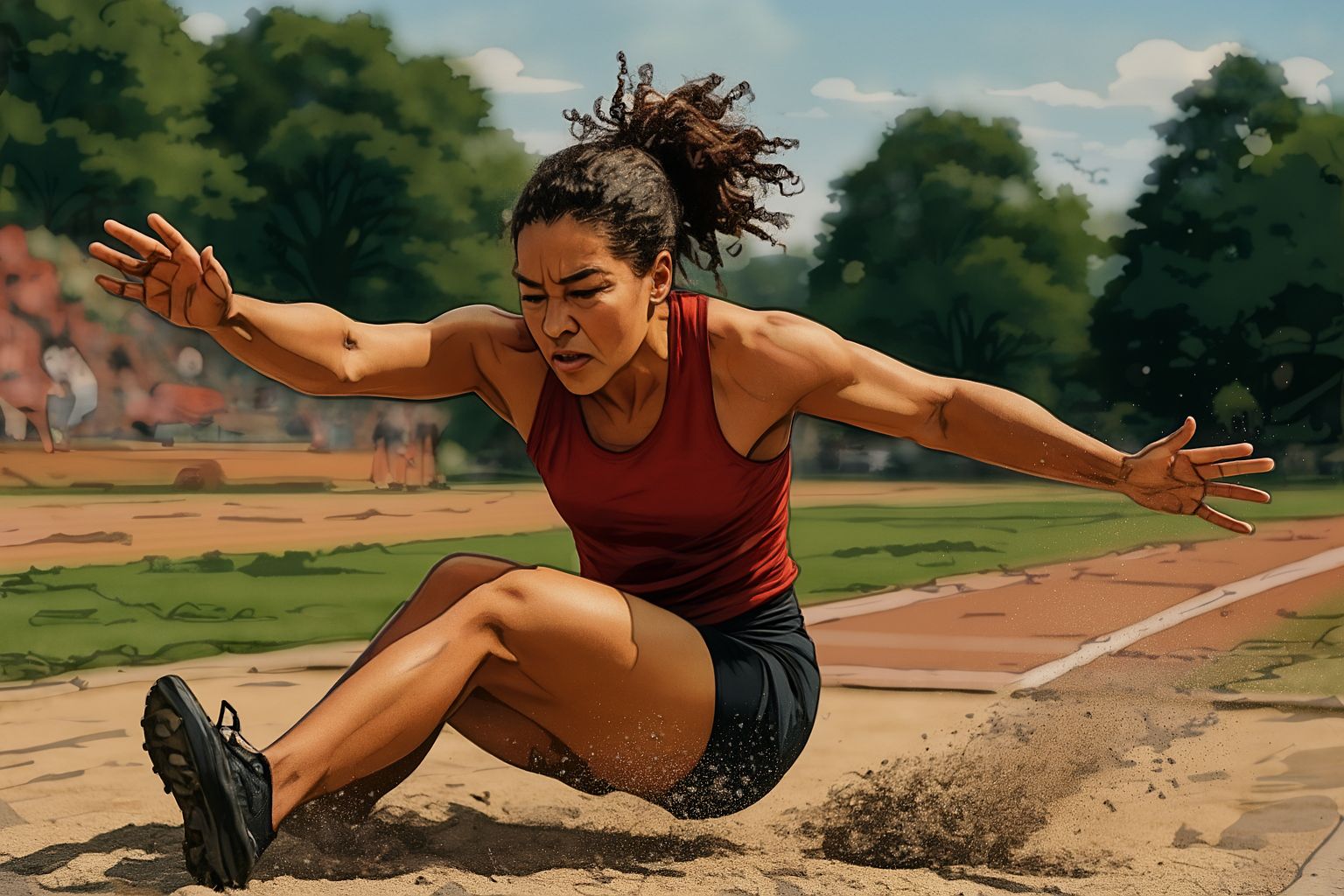The Power Behind Every Jump: Strength and Conditioning for Jumpers
Jumping events in track and field require a combination of explosive power, speed, and precise technique. Whether you’re an aspiring long jumper, high jumper, or triple jumper, the strength and conditioning program you follow will determine your success. Without a strong foundation, your performance will plateau, and your potential will be limited. But when you train with purpose, discipline, and the right strategy, the sky’s the limit.
In this article, we’ll explore the best strength and conditioning workouts tailored to jumping events. We’ll discuss how to build explosive power, enhance agility, improve flexibility, and refine your technique so you can elevate your jumping performance and take your athleticism to the next level.
Why Strength and Conditioning is Essential for Jumpers
To excel in any jumping event, explosive strength is the foundation. Jumpers rely on their ability to produce a massive amount of force in a short time, whether it’s for vertical takeoff in the high jump, horizontal acceleration in the long jump, or the three phases of the triple jump. This burst of power doesn’t come from simple endurance; it comes from properly conditioned muscles that are capable of handling explosive movements.
Strength training develops the muscles required to create force, while conditioning enhances your ability to sustain that power through multiple jumps and in competition settings. For jumpers, strength and conditioning workouts not only help improve performance but also reduce the risk of injury, keep the body balanced, and increase overall athletic endurance.
By incorporating a well-rounded strength and conditioning routine, you’ll develop the explosive force, flexibility, and stamina required to dominate in the air and on the ground.
Building Explosive Power for Takeoff
Explosive power is the cornerstone of jumping. Whether you’re clearing a high bar or launching yourself forward in the long jump, every jump starts with a powerful takeoff. Plyometric exercises are a critical part of developing this explosive strength. These exercises mimic the stretch-shortening cycle that happens in jumping movements, helping you build the speed and force you need for maximum height or distance.
Plyometric exercises like box jumps, depth jumps, and bounding challenge the muscles to produce force rapidly, simulating the motion of a jump. Box jumps, for example, force you to explode upward onto a raised platform, activating your quads, glutes, and calves, while depth jumps involve dropping from a height and immediately jumping upward upon landing. These exercises train your body to react quickly and produce powerful takeoffs.
As you progress, increase the intensity and height of your jumps, but be mindful of your technique to avoid injury. Training with both vertical and horizontal plyometrics is key to mastering the different types of jumps.
Strengthening the Lower Body for Power and Stability
While explosive power is vital for a successful jump, raw strength is equally important. The legs are the primary drivers behind your jump, so focusing on lower body strength is critical. Squats, lunges, and deadlifts are essential exercises that build the strength needed to propel your body upward or forward.
Squats are a must in any jumper’s strength routine, as they target the quads, hamstrings, glutes, and core. These muscles are the key to generating force during the takeoff phase of the jump. Deadlifts, another essential exercise, improve posterior chain strength, which helps with the upward force needed for vertical jumps. Lunges strengthen the stabilizer muscles in your legs, improving balance and coordination, which is essential when you’re leaping through the air.
For jumpers, the emphasis should be on heavy compound movements to build overall strength. Perform squats and deadlifts with challenging weights to develop maximal force, while adding in dynamic movements like walking lunges to build endurance and stability. The goal is to create strong, powerful legs that will carry you through your jump with force and control.
Agility Training for Jumpers: Speed and Coordination
In jumping events, agility is a crucial component that allows for smooth, controlled movements in both your approach and takeoff. For the long jump and triple jump, being able to accelerate quickly and change direction efficiently is critical to generating maximum force for takeoff. Agility training helps to improve foot speed, coordination, and reaction time, all of which are necessary for perfecting your jump.
Drills like ladder drills, cone drills, and shuttle runs will help improve your agility. Ladder drills improve foot speed and coordination, as they require rapid movement through small spaces while maintaining control. Cone drills can help develop quick direction changes, which is especially important for events like the triple jump, where timing and precision between phases are key.
Agility is also important for maintaining balance and control after takeoff, especially in the long jump and triple jump. With the right agility training, you’ll be able to control your body mid-air and land with precision, reducing the chance of injury and maximizing your distance or height.
Flexibility and Mobility: Key for Efficient Jumps
Flexibility and mobility are often overlooked in strength and conditioning routines, yet they are crucial for jumpers. Flexibility helps you achieve better range of motion during the takeoff, which is essential for reaching the necessary height or distance. Mobility exercises for the hips, ankles, and calves will ensure that you can achieve proper body positioning during your approach, takeoff, and landing.
Dynamic stretching exercises should be incorporated into your warm-up routine to increase flexibility and prepare your muscles for explosive movements. Focus on hip flexors, hamstrings, and calves, as these areas are directly involved in the jumping motion. Perform leg swings, high knees, and walking lunges to prepare these muscles for action.
Static stretching should follow your workout and target the same muscle groups to maintain and improve flexibility over time. Foam rolling and myofascial release techniques will also help alleviate tightness and improve mobility, ensuring that your muscles are able to move freely during jumps.
Core Strength and Stability for Power Transfer
The core is the powerhouse of your body, and a strong core is essential for transferring the energy produced in the lower body to the upper body during a jump. A stable core helps maintain proper posture and form while also improving balance and stability during the airborne phase of your jump.
Core exercises such as planks, Russian twists, and medicine ball slams will target the muscles of the abdomen, lower back, and obliques. These exercises build the strength and stability needed for maintaining form mid-air and controlling your movements as you land. A strong core also helps with explosive movements during takeoff, ensuring that the energy you generate in your legs is transferred efficiently through the rest of your body.
For jumpers, it’s important to focus on dynamic core training that challenges stability and strength. Incorporate exercises like medicine ball rotations or hanging leg raises, which engage multiple core muscles while improving functional strength for jumping.
Sample Strength and Conditioning Workout for Jumpers
Now that we’ve discussed the essential components of strength and conditioning for jumpers, let’s look at a sample workout plan. This routine combines explosive power, strength, agility, and mobility training into one comprehensive program. Perform this workout 3-4 times per week, ensuring that you have at least one rest day between sessions.
Warm-Up (10-15 minutes)
Dynamic stretching (leg swings, high knees, walking lunges)
Agility drills (ladder drills, cone drills)
Strength and Power (30-40 minutes)
Squats (4 sets of 6-8 reps)
Deadlifts (3 sets of 5 reps)
Box jumps (3 sets of 10 reps)
Walking lunges (3 sets of 12 reps each leg)
Agility and Speed (20-30 minutes)
Cone drills (3 sets of 5 reps)
Short sprints (10-20 meters, 6 sets)
Shuttle runs (4 sets of 5 reps)
Core Training (15-20 minutes)
Planks (3 sets of 1-minute holds)
Russian twists (3 sets of 20 reps)
Medicine ball slams (3 sets of 15 reps)
Cool-Down (10-15 minutes)
Static stretching (focus on hip flexors, hamstrings, quads)
Foam rolling and myofascial release
Fueling Your Body for Maximum Performance
Strength and conditioning workouts demand a lot from your body, and fueling yourself properly is essential to maximizing your performance. Make sure you’re consuming enough protein to support muscle repair and growth, as well as complex carbohydrates to provide energy for explosive movements. Hydration is also key—dehydration can impair performance and increase the risk of injury.
Post-workout nutrition should include a mix of protein and carbohydrates to replenish muscle glycogen and promote recovery. A balanced diet will not only help improve your strength and conditioning but will also keep you feeling energized and focused throughout your training.
Unlock Your Full Potential: Train with Purpose
To be successful in jumping events, you need more than just raw talent—you need a solid, consistent strength and conditioning program. Focus on building explosive power, developing leg strength, improving your agility, and enhancing flexibility. Work on your core strength to ensure efficient energy transfer and better control during your jumps.
Remember, champions aren’t made overnight. They’re made through relentless training, discipline, and the willingness to push through challenges. If you train with purpose and stay consistent, there’s no limit to what you can achieve. Keep challenging yourself, and soon, you’ll see the results in your jumping performance.
Elevate Your Jumps, Elevate Your Life
Success in jumping events doesn’t come easy, but the rewards are worth the effort. Every workout, every jump, and every step you take on the track is an opportunity to get closer to your goals. Keep pushing yourself, stay motivated, and let every jump you make be a reflection of your hard work, determination, and passion for excellence. The sky’s the limit, and the world is waiting to see you soar.




